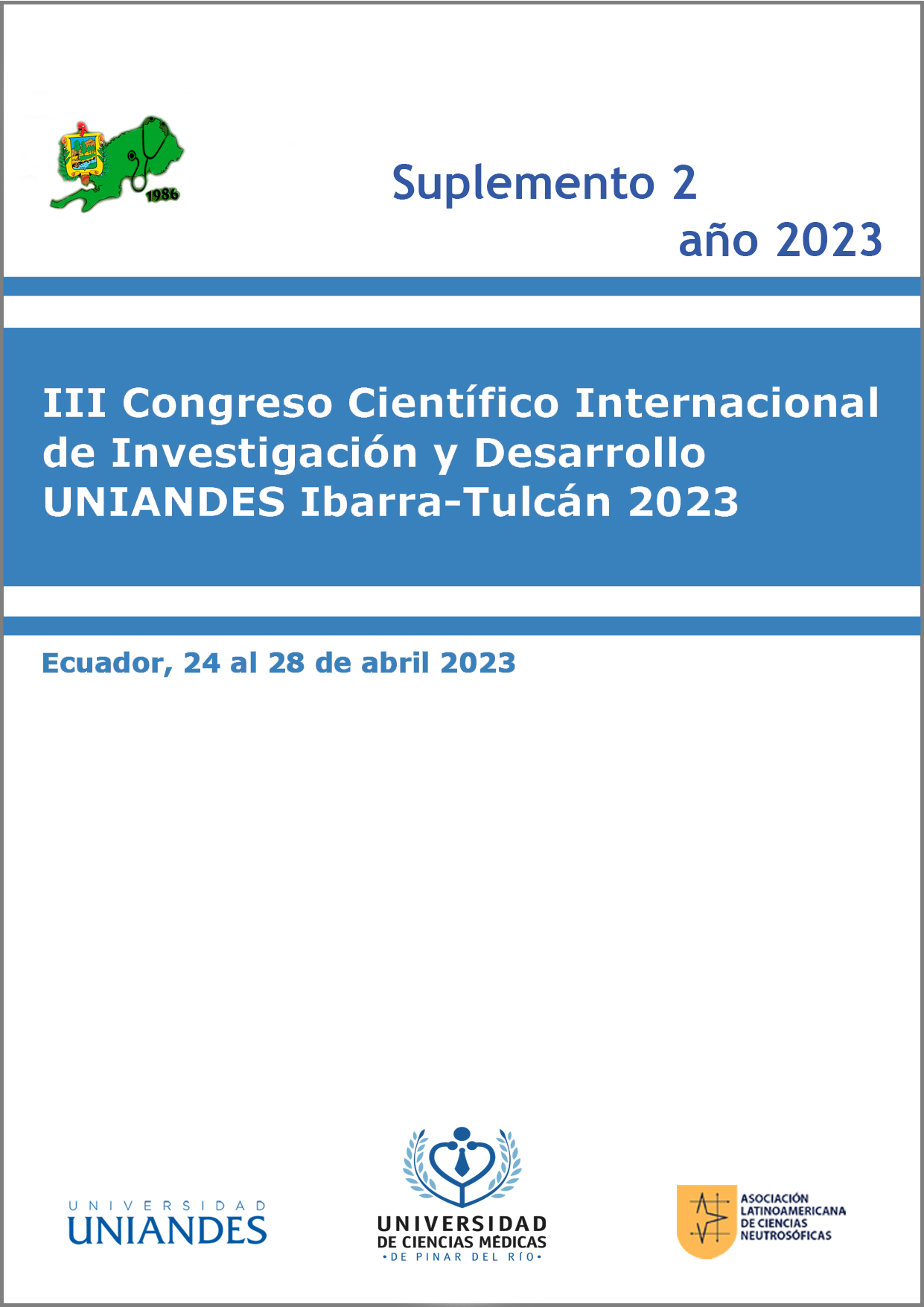Some considerations on women's sexuality in the perimenopausal period
Keywords:
CLIMACTERIC, MENOPAUSE, SEXUALITY, LIFE STYLE.Abstract
Introduction: the sexual sphere in the human being has a remarkable relevance, and can be affected by physiological processes such as the onset of menopause.
Objective: to characterize the sexuality of women in perimenopausal stage.
Methods: a review of the literature on sexuality during the climacteric and menopausal period was carried out in the Scopus, PubMed/MedLine and SciELO databases. A search formula using a combination of terms was used to search for information.
Results: the physiology of female hormones changes over the years, as well as the repercussion of these hormonal changes and the clinical manifestations both in the female reproductive system and at a systemic level. It is necessary to emphasize lifestyle changes and individualization of patients to initiate hormonal treatment, taking into account the benefits, risks and contraindications of the treatments.
Conclusions: sexuality is a process inherent to life, as well as menopause, which is a physiological process that modifies the sexual response cycle. Menopause does not necessarily mark the cessation of sexual life. Healthy lifestyle habits and protection against sexually transmitted infections, together with a solid orientation, are essential elements to achieve a healthy sexuality during menopause.
Downloads
References
1. Torres Jiménez AP, Torres Rincón JM. Climaterio y menopausia. Rev. Fac. Med. (Méx.) [Internet]. 2018 [citado 06/07/2023]; 61(2):51-58. Disponible en: http://www.scielo.org.mx/scielo.php?script=sci_arttext&pid=S0026-17422018000200051&lng=es.
2.. Henrique Morgado S. Climate action in Greece, Latest state of play. European Parliamentary Research Service [Internet]; 2021 [citado 06/07/2023]. [aprox 6pp]. Disponible en: https://www.europarl.europa.eu/RegData/etudes/BRIE/2021/690685/EPRS_BRI(2021)690685_EN.pdf
3. Ambikairajah A, Walsh E, Cherbuin N. A review of menopause nomenclature. Reprod Health [Internet] 2022 [citado 06/07/2023]; 19:29. Disponible en: https://reproductive-health-journal.biomedcentral.com/articles/10.1186/s12978-022-01336-7
4. O’Neill S, Eden J. The pathophysiology and therapy of menopausal symptoms. Obstet Gynaecol Reprod Med [Internet]. 2020 [citado 06/07/2023]; 30(6):175-83. Disponible en: https://linkinghub.elsevier.com/retrieve/pii/S1751721420300579
5. Jaramillo AC, Campuzano MG, Balthazar GV. Dynamic testing in endocrinology: Precocious puberty. Medicina & Laboratorio [Internet]. 2009 [citado 06/07/2023]; 15(07-08): 311-327. Disponible en: https://www.medigraphic.com/cgi-bin/new/resumenI.cgi?IDARTICULO=27792
6. Estepa Galindo E, Prado Martínez C, Carmenate Moreno M, Acevedo Cantero P, García García C de J, Marrodán Serrano MD. Edad de menopausia, condición nutricional y componentes del síndrome metabólico en mujeres españolas. Nutr Clín Diet Hosp [Internet]. 2020 [citado 06/07/2023]; 40(4): 79. Disponible en: https://revista.nutricion.org/index.php/ncdh/article/view/79
7. Fernández Barriga H Ángela, Hernández Quimbiulco CI, Pacheco Romero KE, Quisilema Ron VA. Síndromes metabólicos en la menopausia. RECIAMUC [Internet]. 2020 [citado 06/07/2023]; 4(2): 46-7. Disponible en: https://www.reciamuc.com/index.php/RECIAMUC/article/view/478
8. Li Y, Zhao D, Wang M, Sun J yi, Liu J, Qi Y, et al. Combined effect of menopause and cardiovascular risk factors on death and cardiovascular disease: a cohort study. BMC Cardiovasc Disord [Internet]. 2021 [citado 06/07/2023]; 21(1): 109. Disponible en: https://bmccardiovascdisord.biomedcentral.com/articles/10.1186/s12872-021-01919-5
9. Sourouni M, Zangger M, Honermann L, Foth D, Stute P. Assessment of the climacteric syndrome: a narrative review. Arch Gynecol Obstet [Internet]. 2021 [citado 06/07/2023]; 304: 855-62. Disponible en: https://doi.org/10.1007/s00404-021-06139-y
10. Lugones Botell M. Aspectos éticos y sociales de la sexualidad de la mujer en el climaterio y la posmenopausia. Rev Cubana Obstet Ginecol [Internet]. 2019 [citado 06/07/2023]; 45(3):e476. Disponible en: http://scielo.sld.cu/scielo.php?script=sci_arttext&pid=S0138-600X2019000300002&lng=es
11. Socarrás-León M, Hernández-Cruz B, Oro-Fonseca Y. Sexualidad en la mujer menopáusica: una reflexión desde la Atención Primaria de Salud. Rev. cuba. obstet. ginecol [Internet]. 2020 [citado 06/07/2023]; 46(1): e706. Disponible en: https://revginecobstetricia.sld.cu/index.php/gin/article/view/706
12. Pop AL, Nasui BA, Bors RG, Penes ON, Prada AG, Clotea E, et al. The Current Strategy in Hormonal and Non-Hormonal Therapies in Menopause—A Comprehensive Review. Life [Internet]. 2023 [citado 06/07/2023]; 13(3): 649. Disponible en: https://www.mdpi.com/2075-1729/13/3/649
13. Del Río JP, Alliende MI, Molina N, Serrano FG, Molina S, Vigil P. Steroid Hormones and Their Action in Women’s Brains: The Importance of Hormonal Balance. Front Public Health [Internet]. 2018 [citado 06/07/2023]; 6: 00141. Disponible en: https://doi.org/10.3389/fpubh.2018.00141
14. Gaba F, Goyal S, Marks D, Chandrasekaran D, Evans O, Robbani S, et al. Surgical decision making in premenopausal BRCA carriers considering risk-reducing early salpingectomy or salpingo-oophorectomy: a qualitative study. J Med Genet [Internet]. 2022 [citado 06/07/2023]; 59(2): 122–132. Disponible en: https://pubmed.ncbi.nlm.nih.gov/33568437/
15. Alva Real MG. Representación simbólica de la menopausia, subjetividad y sexualidad. Cuicuilco. Rev cienc antropol [Internet]. 2019 [citado 06/07/2023]; 26(76): 85-105. Disponible en: http://www.scielo.org.mx/scielo.php?script=sci_arttext&pid=S2448-84882019000300085&lng=es&tlng=es.
16. Durairaj A, Venkateshvaran S. Determinants of Menopausal Symptoms and Attitude Towards Menopause Among Midlife Women: A Cross-Sectional Study in South India. Cureus [Internet]. 2022 [citado 06/07/2023]; 14(9): e28. Disponible en: https://doi.org/10.7759/cureus.28718
17. Shamsalizadeh N, Rouhana N, Pierce CS, Swain MA. Formation of Diverse Meanings of Menopause: An Integrative Literature Review. Int J Women’s Heal Reprod Sci [Internet]. 2023 [citado 06/07/2023]; 11(2): 45-57. Disponible en: https://www.ijwhr.net/pdf/pdf_IJWHR_676.pdf
Downloads
Published
How to Cite
Issue
Section
License
Authors who have publications with this journal agree to the following terms: Authors will retain their copyrights and grant the journal the right of first publication of their work, which will be publication of their work, which will be simultaneously subject to the Creative Commons Attribution License (CC-BY-NC 4.0) that allows third parties to share the work as long as its author and first publication in this journal are indicated.
Authors may adopt other non-exclusive license agreements for distribution of the published version of the work (e.g.: deposit it in an institutional telematic archive or publish it in a volume). Likewise, and according to the recommendations of the Medical Sciences Editorial (ECIMED), authors must declare in each article their contribution according to the CRediT taxonomy (contributor roles). This taxonomy includes 14 roles, which can be used to represent the tasks typically performed by contributors in scientific academic production. It should be consulted in monograph) whenever initial publication in this journal is indicated. Authors are allowed and encouraged to disseminate their work through the Internet (e.g., in institutional telematic archives or on their web page) before and during the submission process, which may produce interesting exchanges and increase citations of the published work. (See The effect of open access). https://casrai.org/credit/



